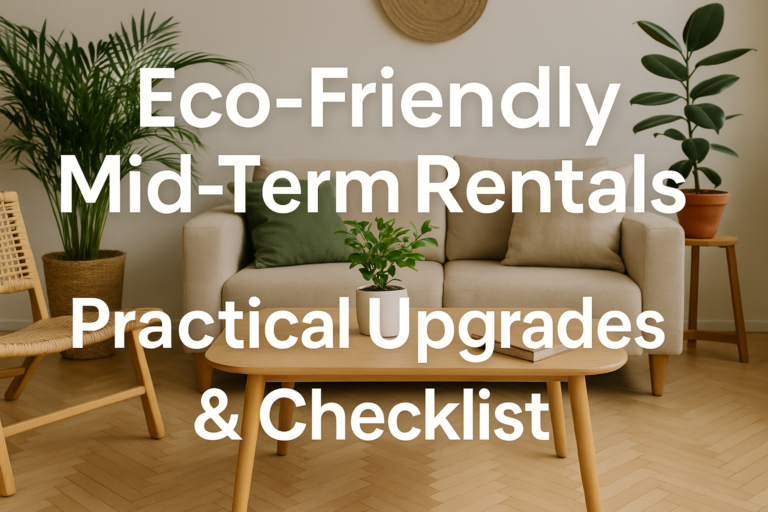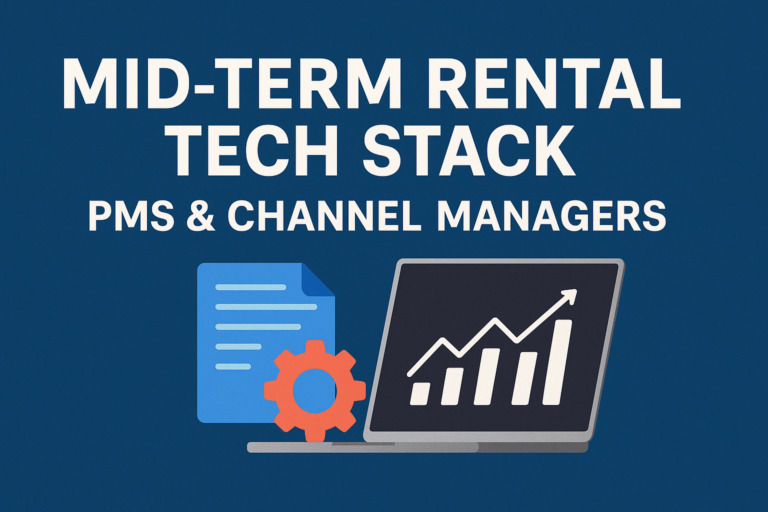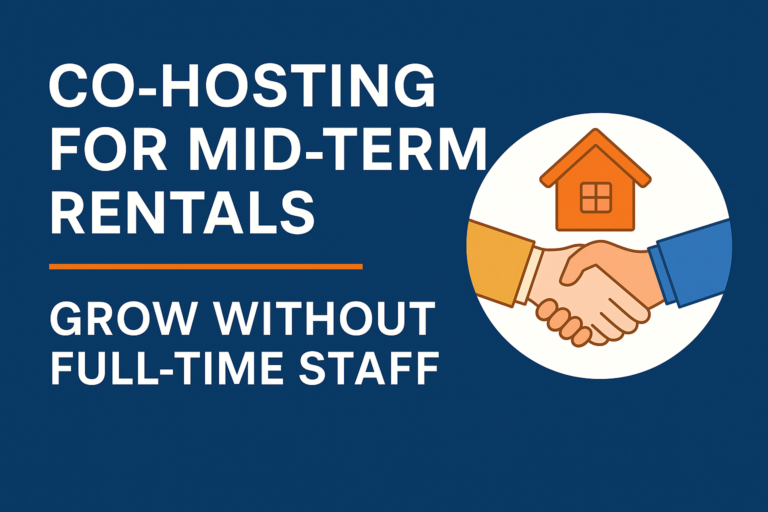Intro — why eco-friendly mid-term rentals pay
Guests who stay a month or more notice the little things: bills, comfort, and how a place treats the neighborhood. Converting a property into an eco-friendly mid-term rental cuts costs, opens new guest segments, and lowers complaint risk. This guide gives practical upgrades, guest-facing messaging, SOP changes, and metrics so your sustainability moves actually matter to your bottom line — part of the Mid-Term Rentals Optimization Playbook — Boost Revenue.
High-impact areas that move the needle fast
Focus on three pockets where small changes return quickly:
- Energy & HVAC: save on monthly utilities.
- Consumables & waste: reduce replacements and single-use supplies.
- Accessibility & community: widen your market and reduce regulatory friction.
These are the core win zones for profitable, eco-friendly mid-term rentals.
Quick wins you can do this month
Low cost, fast ROI.
- Replace bulbs with LEDs and retrofit fixtures.
- Install a smart thermostat and lock sensible ranges.
- Fit faucet aerators and low-flow showerheads.
- Swap single-use toiletries for bulk dispensers.
- Buy durable mattresses and stain-resistant upholstery.
- Add clear recycling + compost bins and short how-to in the welcome guide.
Communicate these in your listing bullets — they convert especially with remote workers and families.
Accessibility upgrades that increase bookings
Small accessibility moves expand your addressable market.
- Publish clear accessibility details in the listing (step-free entry, elevator, grab bars available).
- Provide a desk with an adjustable chair and good lighting.
- Offer large-print house guides and an option for phone-call check-ins.
- Keep a portable ramp and temporary grab bar kit for quick installs.
Accessibility + eco messaging differentiates you for longer-stay professionals and relocation clients.
Community relations — be the host your building trusts
Good neighbor relations reduce complaints and speed approvals.
- Share your SOPs with building management (quiet hours, emergency contacts).
- Hire local cleaners and trades — local spending builds goodwill.
- Create a one-page neighborhood guide with rules, transit, and local partners (cafés, laundromats).
- Respond to any concern within 24 hours and log actions.
Local trust turns into referrals and fewer enforcement headaches.
SOP changes to lock in green behavior
Make sustainability operational, not optional.
- Turnover checklist: verify bulk dispenser fill levels and recycling bins.
- Maintenance SOP: repair-first policy and parts inventory logging.
- Purchases: prefer durable or refurbished furnishings with known replacement parts.
- Guest handbook: clear instructions on thermostat use, recycling, and composting.
Train your VA/co-hosts on the new SOPs — automation and checklists enforce them.
Guest messaging that converts (examples)
Use real, utility-forward messaging.
Headline bullet: “Eco-friendly, fully furnished — 30+ day stays. LEDs, smart thermostat, recycling.”
Lead bullet example: “Save on utilities + enjoy a dedicated workspace — 60+ day discounts available.”
Welcome card blurb: “We keep things low-waste: bulk toiletries, recycling, and local tips. Questions? Reply — we’ll help.”
Short, specific claims beat vague green language.
Measure it — KPIs for eco-friendly mid-term rentals
Track simple, dollar-focused metrics.
- kWh per occupied month (energy).
- Water usage per occupied month.
- Turnover cost per booking (should decline).
- Repeat guest rate and average length of stay.
- Guest satisfaction on comfort/cleanliness/accessibility.
Tie improvements to contractor bonuses where appropriate.
Cost vs benefit — where to invest first
Prioritize by payback and guest value.
- LEDs, aerators, bulk dispensers — immediate savings.
- Smart thermostat, durable mattress, workspace — medium cost, high retention.
- Accessibility kit and robust community program — longer-term payoff via bookings and lower friction.
Aim for under 18–24 months payback on most upgrades.
Quick implementation checklist (this week) for eco-friendly mid-term rentals
- Swap all bulbs to LED.
- Install aerators and a smart thermostat.
- Add bulk dispensers in bath & kitchen.
- Update listing bullets and welcome guide with eco + accessibility notes.
- Hire a local cleaner who follows low-impact practices.
- Start tracking energy and water use per month.
Do these and you’ll see lower bills and cleaner reviews fast.
FAQs about eco-friendly mid-term rentals
Q: Do guests pay more for eco-friendly features?
A: Not always directly — but eco features increase conversion and length of stay for many longer-stay segments.
Q: Will bulk dispensers upset guests?
A: No — most guests prefer tidy, refillable dispensers (clean design) over small single-use bottles.
Q: Are accessibility investments worth it?
A: Yes — even small accessibility features open up larger, higher-value guest pools and reduce liability risk.
Final note & CTA — rolling out eco-friendly mid-term rentals (where to list)
Making properties eco-friendly and accessible is both a values play and a business play. Start with three concrete changes, measure the savings and guest response, then roll out across units.
If you want a marketplace that attracts month-plus guests while you test these upgrades, list your units on MiniStays — it’s built for 30+ day stays and draws professionals who appreciate comfort, convenience, and responsible hosting.
Start hosting on MiniStays → https://ministays.com



